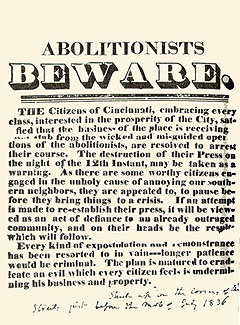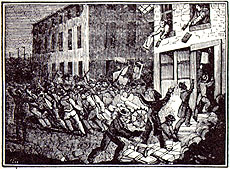
NOTICE POSTED IN CINCINNATI
The American Historical Society
The basic facts are these:
in the Spring of 1836 James Birney began publishing The
Philanthropist, his anti-slavery weekly, in Cincinnati;
at midnight on July 12, after a series of warnings that the paper should
cease publication, a band of men (including some of the most powerful and
wealthy in the city) broke into the office of Birney's printer and tried to
destroy his press;
when Birney resumed publication, and after a series of public meetings
and warnings, on the night of July 30 a mob of at least several hundred men
went on a rampage against the paper, abolitionists and members of the city's
community of free blacks.
Although prepared by the Ohio Anti-Slavery Society, the Narrative below
gives a good account of the larger story, including the way the excitement was
stirred up and reported in the Cincinnati papers.
Two main fears lay behind the attempt to silence the discussion of slavery in Cincinnati: the fear of offending slave owners across the river, whose money was an major engine of the city's prosperity, and the fear that the abolitionists would make the city's African American population less tractable. (The rioters, for example, burned down several buildings in which blacks and whites were known to mingle.)
Harriet Beecher Stowe was in Cincinnati through the excitement; her reaction to it is included below. Anti-abolitionist violence occurred in a number of Northern communities during the late 1830s; also included below is the account by Stowe's brother of how Arthur Lovejoy was murdered while defending his printing press in Illinois.

